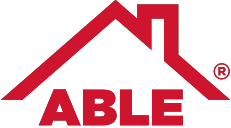Have you noticed unattractive black streaks running down your roof and wondered what causes them? Most homeowners assume that these streaks are caused by any number of things ranging from mold and mildew to soot. The real cause of these unsightly marks on your roof is algae.
The reason most people don’t consider algae is because we think of algae as being green. This variety, however, forms a dark pigmentation that coats its exterior and protects it from the harmful UV rays of the sun.
These algae growths are most common on asphalt shingles, although they can be found on any type of roofing. They begin as small spots that homeowners typically overlook. Then, after several months, they become the black streaks we see.
What causes algae growth on my roof?
Spores propagate the algae that grow on your roof. These spores can be spread very quickly, as they are airborne. Birds, animals, and wind carry the spores and disperse them throughout neighborhoods.
Moisture is a contributing factor to algae growth, as well as the effects of sunlight. Since coastal climates tend to be warmer and more humid, they are particularly conducive to algae growth, but it has become a problem across the country, even in colder regions. Sunlight is a factor that you will understand if you mainly see algae on the north side of your home. Since the north side of the roof tends to get the most shade as the sun moves through the sky, moisture accumulates more there, which creates an environment that is just right for algae to thrive.
What do these streaks mean for the viability of my roof?
Other than making your roof look unattractive and damaged, the most significant effect that algae will have on the shingles involves their longevity. The algae that form on your roof are not dangerous or harmful to you or your family, but it causes the granules on the shingles to fall off. Since these granules are there to protect the roof from the sun’s UV rays, they begin to dry out as the granules wash away.
Another damaging element that algae growth creates is an environment that encourages the growth of fungus. Fungus is also spread through the air, and when it lands on your roof, it can combine with the algae to form lichen. Lichen feeds off the shingle filler, which acts to erode the roofing material further. It also creates roots, which makes it difficult to remove. For this reason, it is vital to move quickly to remove algae from your roof.
Can I get rid of algae on my roof?
We don’t recommend a DIY approach to cleaning your roof. Most cleaning solutions contain chemicals that are corrosive and can be dangerous to use, and anyone applying this type of solution should be wearing full protective gear. As well, it is very easy to irreparably damage your shingles by washing away the granules that give shingles their integrity. The best thing you can do is to schedule a roofing inspection and see what the professionals say.
Algae-resistant shingles
At Able, all of our shingles are algae-resistant. They are developed with a special, non-toxic formula that inhibits the growth of algae, without damaging the environment around your home. If your roof suffers unsightly algae, it is also most likely damaged—or will be soon, due to the inevitable granule loss. Contact Able Roof to schedule a free assessment of your roof.








